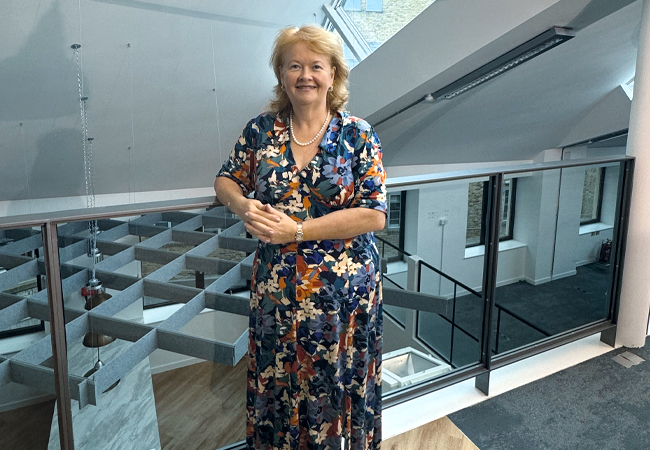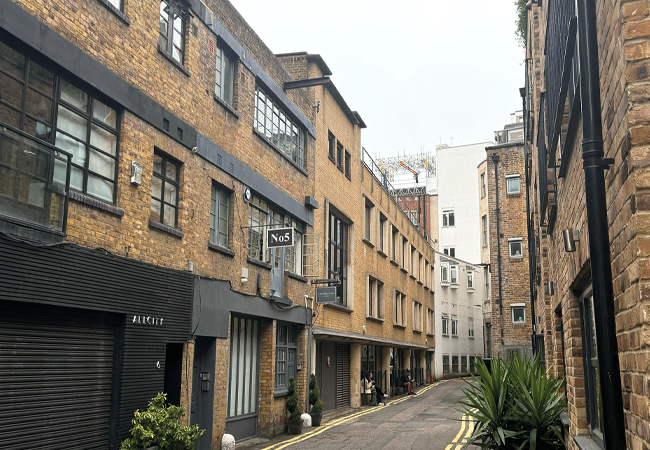
After 44 years, CIBSE is moving back to central London, following the purchase of a new head office in the vibrant cultural and business district of Farringdon.
The acquisition of 91-94 Saffron Hill comes two years after CIBSE CEO Ruth Carter announced that the Institution was planning to sell its Balham premises and move to a new location that would better serve the interests of staff and members. At 17,000sq ft, the six-storey building is 70% larger than Balham, and has a variety of flexible spaces that will be able to accommodate the multiple requirements of CIBSE’s varied and growing membership.
‘This is a building that CIBSE can be proud of,’ says Carter, who spearheaded the move. ‘When we think about CIBSE being insightful, leading and challenging – and providing omnipotent guidance – this is the perfect building to embody that vision.’
The offices are arranged over the lower-ground, ground and three upper floors. The second and third floors are linked, and benefit from a vaulted ceiling with large glazed sections and a double-height space. There will be around 60 desks on the upper two storeys for CIBSE’s 75 staff, as well as meeting rooms and breakout spaces, which will encourage collaboration and flexible working.
CIBSE had three main objectives when choosing the new head office: it had to meet the Institution’s requirements, be centrally located for staff, and have the opportunity to reach its decarbonisation goals/aims. It also had to suit CIBSE Members and partners, be affordable, support modern, global working practices, and act as a net zero demonstration project.
The premises advisory committee
The relocation of CIBSE’s head office has been driven by the premises advisory committee, chaired by past CIBSE vice-president Paddy Conaghan.
Its members set the parameters for the type of building CIBSE was looking for after sub-groups had looked at finance and funding, building performance, FM, communications, and people and culture.
Carter says: ‘We have used our CIBSE skill sets and reached out to special interest groups and societies to gather information.’
With the members’ community in mind, the ground and lower-ground floors will be remodelled into a theatre with capacity for 100 people, plus an area that will feature training rooms, workspaces, a space to relax, showers and a kitchen. The theatre will be ready for the 2025 CIBSE AGM.
Carter envisages the ground floor being a dynamic hub for CIBSE. ‘We have a huge umbrella of networks that could use the building. Members might have meetings during the day and a black-tie event in the evening. They can get changed for the evening, leave their luggage here, and call this place their home while they are in London.’
CIBSE will run the space as a members’ area for a year and, if it proves popular, will invest in more facilities. ‘The flexibility of the building allows us to expand and adapt as needed,’ Carter adds.

Originally two buildings dating back to 1957, the site was extensively refurbished by architect Tooley Foster in 2010. The rear of the building is on Hatton Place
The building is only three minutes’ walk from the Elizabeth Line tube at Farringdon Station and its central London location was a major plus for Carter. ‘Connectivity is through the roof at Saffron Hill. It’s so easy to get to from London’s major transport hubs – 29% of our members are from outside the UK and, if they land at Heathrow, they can get the Tube directly here,’ she says.
The location of the Balham office, multiple stops down the Northern Line, was one of the main reasons Carter wanted to relocate rather than refurbish. ‘I once said to someone at Hoare Lea “have you been to Balham?”, and he said yes – but he also said it may well have been Ulan Bator [the capital of Mongolia],’ she says.
‘There was a plan to sell off the engineering centre at Balham and refit the main building, but the issue was that it was still going to be Balham.’
With its mix of business, cultural and creative industries, Farringdon – which has been rapidly gentrifying since the 1990s – has the ‘white noise of buzz and energy’ that Carter says Balham lacks. The area will have another major boost in 2026 with the opening of the London Museum at nearby Smithfield Market. The transformation of the historic market into a world-class cultural destination is featured here.
We have a huge umbrella of networks that could use the building. It’s their hub in town
CIBSE’s new property is located on the western side of Saffron Hill, near the junction with St Cross Street, and is close to London’s famous Hatton Garden jewellery quarter. The immediate vicinity now boasts an array of retail and leisure offerings, including Leather Lane Market.
The area also has a literary history – Saffron Hill was the location of Fagin’s hideout in Charles Dickens’ Oliver Twist. The hostelry that inspired the Three Cripples pub, where Bill Sykes drank, is a few doors down from CIBSE’s new home.
The move offers the Institution an opportunity to use its expertise to share best practice in decarbonising a commercial property. ‘I want the solutions to work in the real world,’ says Carter.
The building has an Energy Performance Certificate rating of B, so there is room for improvement, but there will be no dramatic services overhaul in the short term. ‘We’re not going to throw away the boiler immediately,’ Carter says. ‘I want to live in the building for at least a year, taking measurements, and then develop a decarbonisation strategy.
‘We can’t just think about operational energy – we must think about embodied energy too. We might find some interventions aren’t necessary. I don’t want to rush in, spend a huge amount of money, then question what we’ve done. We will have broad decarbonisation targets when we move in, but how and when we get there will be determined by living in the building.’
Carter is keen to share the decarbonisation journey with members: ‘We want to live this publicly – we want people to know what we tried, what’s worked really well, and what hasn’t.’
The deal for the premises was concluded last month, and Carter is keen to move to Saffron Hill as soon as possible. She is looking forward to opening its doors to members and the wider industry, and discussions have already taken place with Clerkenwell Design Week about hosting festival events.
‘This building is a beauty, and looks better in real life. We have a head office to be proud of,’ says Carter.
- CIBSE’s new Head Office should be ready to welcome members in autumn 2025.
